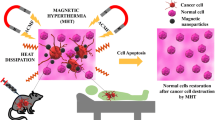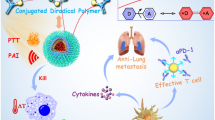Abstract
The use of superparamagnetic iron oxide nanoparticles (SPIONs) as a sensitizer in photothermal therapy (PTT) is relatively new and the origin of such a phenomenon is not known. Usually, large crystals and aggregated particles are preferred in the literature, suggesting that these increase the absorbance of particles at the irradiation wavelength, and hence, provide a larger temperature increase. This study has two major goals: identification of the key factors that affect the photo-induced temperature increase in well-controlled experiments and the influence of laser irradiation on nanoparticle properties. Small, biocompatible poly(acrylic acid) coated SPIONs (PAA/SPIONs) were used since they are more practical for future medical use than large aggregates. We studied the impact of three major laser-dependent variables, namely the wavelength (between 728 and 838 nm), intensity (1.85–9.76 W cm−2) and power (105–800 mW) as well as attenuation at the irradiation wavelength, on photothermal heating achieved with PAA/SPIONs. Within the studied range of these variables, only the laser power plays a critical role on the magnitude of photothermal heating in solutions. There is no strong correlation between the attenuation at the excitation wavelength and the temperature increase. In addition, extensive characterization of SPIONs before and after irradiation revealed no significant difference, which supports the re-usability of SPIONs. Lastly, the PTT potential of these small PAA/SPIONs was demonstrated in vitro on HeLa cells. At these low laser powers no temperature increase in SPION-free water or cell death in SPION-free cells was detected. Hence, this study provides a new insight into the photothermal effect of SPIONs, provides a clear and repeatable experimental procedure and demonstrates great potential for small SPIONs to be exploited in PTT.
Similar content being viewed by others
References
B. Chertok, A. E. David and V. C. Yang, Biomaterials, 2010, 31, 6317–6324.
B. Chertok, B. A. Moffat, A. E. David, F. Yu, C. Bergemann, B. D. Ross and V. C. Yang, Biomaterials, 2008, 29, 487–496.
C. Hopper, Lancet Oncol., 2000, 1, 212–219.
D. Bechet, P. Couleaud, C. Frochot, M.-L. Viriot, F. Guillemin and M. Barberi-Heyob, Trends Biotechnol., 2008, 26, 612–621.
X. Wang, K. Liu, G. Yang, L. Cheng, L. He, Y. Liu, Y. Li, L. Guo and Z. Liu, Nanoscale, 2014, 6, 9198–9205.
D. Jaque, L. M. Maestro, B. Del Rosal, P. Haro-Gonzalez, A. Benayas, J. Plaza, E. M. Rodriguez and J. G. Sole, Nanoscale, 2014, 6, 9494–9530.
X. Huang, I. H. El-Sayed, W. Qian and M. A. El-Sayed, J. Am. Chem. Soc., 2006, 128, 2115–2120.
H. K. Moon, S. H. Lee and H. C. Choi, ACS Nano, 2009, 3, 3707–3713.
E. B. Dickerson, E. C. Dreaden, X. Huang, I. H. El-Sayed, H. Chu, S. Pushpanketh, J. F. McDonald and M. A. El-Sayed, Cancer Lett., 2008, 269, 57–66.
K. Yang, S. Zhang, G. Zhang, X. Sun, S.-T. Lee and Z. Liu, Nano Lett., 2010, 10, 3318–3323.
X. Liu, H. Tao, K. Yang, S. Zhang, S.-T. Lee and Z. Liu, Biomaterials, 2011, 32, 144–151.
M. S. Yavuz, Y. Cheng, J. Chen, C. M. Cobley, Q. Zhang, M. Rycenga, J. Xie, C. Kim, K. H. Song and A. G. Schwartz, Nat. Mater., 2009, 8, 935.
H. Ke, J. Wang, Z. Dai, Y. Jin, E. Qu, Z. Xing, C. Guo, X. Yue and J. Liu, Angew. Chem., 2011, 123, 3073–3077.
M.-F. Tsai, S.-H. G. Chang, F.-Y. Cheng, V. Shanmugam, Y.-S. Cheng, C.-H. Su and C.-S. Yeh, ACS Nano, 2013, 7, 5330–5342.
M. Potara, S. Boca, E. Licarete, A. Damert, M.-C. Alupei, M. T. Chiriac, O. Popescu, U. Schmidt and S. Astilean, Nanoscale, 2013, 5, 6013–6022.
R. He, Y.-C. Wang, X. Wang, Z. Wang, G. Liu, W. Zhou, L. Wen, Q. Li, X. Wang and X. Chen, Nat. Commun., 2014, 5, 4327.
M. Zhou, R. Zhang, M. Huang, W. Lu, S. Song, M. P. Melancon, M. Tian, D. Liang and C. Li, J. Am. Chem. Soc., 2010, 132, 15351–15358.
N. Lee and T. Hyeon, Chem. Soc. Rev., 2012, 41, 2575–2589.
U. I. Tromsdorf, O. T. Bruns, S. C. Salmen, U. Beisiegel and H. Weller, Nano Lett., 2009, 9, 4434–4440.
H. B. Na, I. C. Song and T. Hyeon, Adv. Mater., 2009, 21, 2133–2148.
M. Johannsen, B. Thiesen, P. Wust and A. Jordan, Int. J. Hyperthermia, 2010, 26, 790–795.
J.-P. Fortin, C. Wilhelm, J. Servais, C. Ménager, J.-C. Bacri and F. Gazeau, J. Am. Chem. Soc., 2007, 129, 2628–2635.
Z. Zhou, Y. Sun, J. Shen, J. Wei, C. Yu, B. Kong, W. Liu, H. Yang, S. Yang and W. Wang, Biomaterials, 2014, 35, 7470–7478.
M. Chu, Y. Shao, J. Peng, X. Dai, H. Li, Q. Wu and D. Shi, Biomaterials, 2013, 34, 4078–4088.
S. Shen, S. Wang, R. Zheng, X. Zhu, X. Jiang, D. Fu and W. Yang, Biomaterials, 2015, 39, 67–74.
A. Espinosa, R. Di Corato, J. Kolosnjaj-Tabi, P. Flaud, T. Pellegrino and C. Wilhelm, ACS Nano, 2016, 10, 2436–2446.
A. K. Gupta and M. Gupta, Biomaterials, 2005, 26, 3995–4021.
A. W. Dunn, S. M. Ehsan, D. Mast, G. M. Pauletti, H. Xu, J. Zhang, R. C. Ewing and D. Shi, Mater. Sci. Eng., C, 2015, 46, 97–102.
H. Chen, J. Burnett, F. Zhang, J. Zhang, H. Paholak and D. Sun, J. Mater. Chem. B, 2014, 2, 757–765.
A. Sennaroglu, U. Demirbas, S. Ozharar and F. Yaman, J. Opt. Soc. Am. B, 2006, 23, 241–249.
Acknowledgments
The authors would like to thank Pelin Tozman for VSM measurements and Dr Baris Yagci (KUYTAM, Koc University) for XPS analysis.
Author information
Authors and Affiliations
Corresponding author
Rights and permissions
About this article
Cite this article
Bilici, K., Muti, A., Demir Duman, F. et al. Investigation of the factors affecting the photothermal therapy potential of small iron oxide nanoparticles over the 730–840 nm spectral region. Photochem Photobiol Sci 17, 1787–1793 (2018). https://doi.org/10.1039/c8pp00203g
Received:
Accepted:
Published:
Issue Date:
DOI: https://doi.org/10.1039/c8pp00203g




